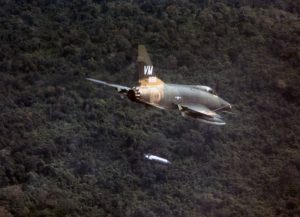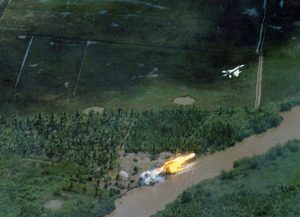Here’s an excerpt from another great story by Dario Leone of The Aviation Geek Club website…
WHEN THE HUN WENT DOWNTOWN: THE STORY OF F-100’S ATTACK ON NORTH VIETNAMESE DEFENSES
…One of [the F-100’s] missions over North Vietnam was acting as lead for other fighter-bombers on radar-controlled bombing missions. Early in the air war, the F-100 was one of the few types to be equipped with ‘Skyspot’…a “ground-directed bombing” (GDB) operation. (1). Using Skyspot, the fighter bombers could bomb through thick cloud cover.
On Nov. 2, 1966, a flight of two F-100D’s assigned to the 416th Tactical Fighter Squadron (TFS), and operated under 7th Air Force’s ‘Operation Southern Brother’, at Danang Air Base (AB), South Vietnam, were tasked to lead a flight of four F-105’s from Takhli Royal Thai Air Base (RTAB) on a radar-controlled bombing mission in the coastal area of North Vietnam. As Drendel explains “the bombing run went as planned and, after completing their primary mission, Captain Arthur J. O’Connell (Silver 11) and Lt. Jim Wallace (Silver 12) joined the F-105’s for a period of low level, high-speed armed reconnaissance along an assigned road segment. The six American fighters streaked low over the lush green countryside, six pairs of eyes searching for North Vietnamese military traffic. As they approached bingo fuel state for the F-105’s, the weather began to deteriorate. The ceilings were down to 3000 feet, and there were intermittent rain showers hampering visibility. No targets of value had been spotted, and the F-105’s bid their Danang based companions farewell, as they turned west and climbed through the overcast, on course for Takhli. During the briefing for this mission, the Intelligence Officer had warned them to be on the lookout for a newly constructed SAM site, and the hope of finding such a choice target, coupled with their still favorable fuel state, had convinced them to continue their reconnaissance.
“The [Huns] had carried no bombs on the bombing mission since it was virtually impossible for a heavily laden F-100 to keep up with the F-105’s, but they still had 800 rounds of 20mm HEI (High Explosive Incendiary) for their nose-mounted M-39 cannon. The destructive power of the 20mm shells would easily overcome any lightly armored vehicle, and each F-100 would be spitting out over 100 of these deadly missiles a minute in their strafing runs.
“The weather continued to deteriorate as the two fighters roared south, condensation trails streaming out behind them in the warm, humid air. As they popped over a small ridgeline, they were confronted by their quarry! They had chanced upon a newly constructed, equipped, and manned SAM site. As they roared over the North Vietnamese position, it was evident that they had caught the enemy completely by surprise. Gunners and technicians were running for cover or gun positions. O’Connell knew that it wouldn’t take the enemy gunners long to get into action and that they would throw up a murderous torrent of flak and tracer to protect their newly established position. He immediately established the attack plan… high speed jinking, low angle opposed strafing passes to neutralize the site and destroy as much of the equipment, knowing that they might sacrifice themselves in doing so because of the fierce opposition of the site gunners.
“The two Super Sabres broke in opposite directions and, dodging behind conveniently located hills, began to curve back around for their firing passes. The communist gunners were ready for them and as they roared into sight low over the trees, the enemy opened up with everything he had. Rapid-fire 57mm and 50-caliber lit up the valley, creating a leaden gantlet for the two F-100’s to run. They bored into point-blank range, O’Connell after the radar dish, while Wallace went for the control van in the center of the complex. The throaty roar of their 20mm was added to the frantic din of anti-aircraft fire. The two Super Sabres were on a converging course at better than 500 knots of airspeed each. The 20mm HEI was erupting from their cannon in cascades, some of it exploding in the air in front of them as the shells went supersonic and then came back through the sound barrier. But enough of the deadly cannon fire was finding it’s mark. The nerve center of the site was a shambles, the radar dish riddled and shredded, the control van little more than a pile of irreparable junk.
“The two F-100’s flashed past each other and, jinking wildly to throw off the enemy gunner’s aim, headed for the high hills surrounding the site. Again they maneuvered behind the hills, and again they flashed out, charging for the SAM site like enraged predators. On this pass, O’Connell hit a liquid fuel storage tank. The tank blew it’s top, sending a pillar of flame shooting straight up. The glare of this fire lit up the gloomy valley, exposing the concealed positions of the SAM missiles themselves. Wallace went after a missile and it’s launcher, shredding both and killing the crew. As they recovered from this pass, O’Connell asked for Wallace’s fuel state. They were both getting dangerously low, and he opted for one more pass, followed by a high-speed, low altitude exit of the area. On their last pass, O’Connell attacked a missile and trailer/launcher, while Wallace demolished an assembly van. The enemy gunners, undaunted by the repeated attacks, had continued to put up a fierce defensive fire. But the elusive tactics of the two Hun drivers had prevented a single enemy shell from finding vitals of their mounts.
“They completed their final firing runs on the site and bent their birds into hard turns away from the wrecked installation. On their way back to Danang they radioed the Air Force’s flying command post, describing the target, it’s location, and the damage they had inflicted. As a result of this information, follow-on flights of F-105’s were directed to the SAM site, and they finished the job started by the Super Sabres. For their aggressive actions, Wallace and O’Connell were awarded The Air Medal. It was the sixteenth time Jim Wallace had been favored with this decoration.”
This was by no means the only attack or the most successful attack on North Vietnamese defenses by F-100’s. The Super Sabre was the first jet aircraft to be used over the north on regularly scheduled missions. The first anti-SAM missions were flown in F-100F ‘Wild Weasel’ aircraft, and the pilots faced tremendous odds with very simple and somewhat unreliable equipment. This type of mission was eventually taken over by the F-105.
Sources:
Dario Leone, AviationGeeks website
Lou Drendel in his book F-100 Super Sabre In Action
(1) Wikipedia
